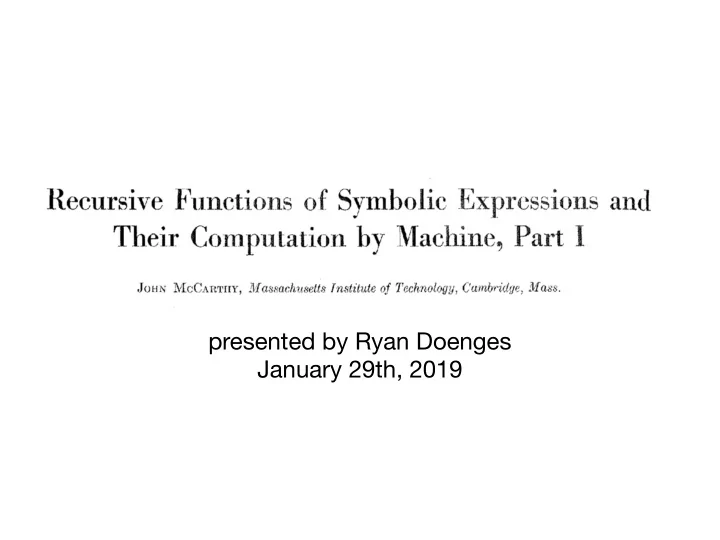

of 1 presented by Ryan Doenges January 29th, 2019
of 1 presented by Ryan Doenges January 29th, 2019
Plan • Historical context • S-expressions, S-functions, M-expressions • eval • Legacy of the paper • Discussion!
Computing in 1960 • Computers like the IBM 704 use vacuum tubes, reels of magnetic tape, punch cards, and cost a lot of money • "the field variously called artificial intelligence, heuristic programming, automata theory, etc." • Algorithms defined in flowcharts (Section 6)
The IBM 704
The IBM 704
PL in 1960 • FORTRAN turns 7 • ALGOL 60 standardized by Backus, Naur, Perlis, McCarthy, et al. • Lambda calculus approaching 30 years of age, considered a subject of purely mathematical interest
S-expressions Abstract syntax: atom ::= A | B | C | ... | AA | AB | ... s-exp ::= Atom atom | Cons s-exp s-exp Let's use modern syntactic sugar instead of the paper's notation. Some examples: () = NIL (A) = (Cons (Atom A) NIL) (A B) = (Cons (Atom A) (Cons (Atom B) NIL))
M-expressions Meta-expressions are the host language or metalanguage and are already equipped with an evaluator, unlike S- expressions. McCarthy writes f[x; y] for M-expression function calls; let's just write (f x y) and distinguish S-expressions by quoting them '(like this) . More on this in a minute.
Primitive S-functions • Predicates: atom , eq • Constructor: cons • Projections: car , cdr , caar , cadr , ... • car is the first thing in the cons cell • c dr is d a r est
Conditional expressions There are distinguished atoms T and F which serve as truth values. McCarthy writes [p 1 → e 1 ; p 2 → e 2 ; ...] for conditionals, but let's write (cond (p 1 e 1 ) (p 2 e 2 ) ...) . The predicates p i are evaluated in order, and if p i evaluates to T then the conditional short-circuits to e i .
Lambdas and recursion Our friend the anonymous function: (lambda (x 1 x 2 ...) e) There's also a special form for defining recursive functions: (label fn (lambda (x 1 x 2 ...) e)) occurs in Is label necessary? Why or why not?
Quotation The quotation operator (page 189, left) takes an M- expression and produces an S-expression which represents it. 'x := X '(f x y ...) := ('f 'x 'y ...) '(cond (p 1 e 1 ) ...) := (COND ('p 1 'e 1 ) '(lambda (x...) e) := (LAMBDA ('x...) 'e)
apply and eval occurs in
apply The function apply takes an S-expression representing a function and then a list of arguments. (apply f args) := (eval (f (appq args))) where appq quotes each element of the list args .
eval The function eval takes a quoted s-expression along with an environment (an association list) and evaluates it. Full definitions are on page 189 . There's some fishy stu ff going on here. For example, what will this evaluate to? ((lambda (x) ((lambda (g x) (g nil)) (lambda (y) x) 2) 1)
(page 190, left column)
Legacy The first functional programming language, even if it got scope wrong S-expressions were necessary for the development of rich macro systems and fancy metaprogramming features present in modern Lisps (Racket/Scheme, Clojure, ...) Automatic memory management Computer algebra and other forms of "symbolic computing" Domain-specific langauges (page 191)
Some discussion questions Were there any concepts or techniques in the paper that felt modern? Any that felt strange or dated? Was LISP a scripting language? How would you describe McCarthy's approach to semantics? What became of M-expressions?
(page 189, left column)
Recommend
More recommend